Buy Carnivorous Plants Online!
Buy carnivorous plants from the most reputable and trusted carnivorous plant nursery, California Carnivores. We have partnered up and are giving all my viewers an exclusive 10% discount on your entire carnivorous plant order! Just enter CPHUB at checkout! Get the coolest venus flytrap cultivars, sarracenia, nepenthes and much MUCH more! You can even buy your next bag of premium carnivorous plant soil from them! Order Plant Mail, Click Here!Venus Fly Trap Care Guide Introduction
| We are a participant in the Amazon Services LLC Associates Program, an affiliate advertising program designed to provide a means for sites to earn advertising fees by advertising and linking to Amazon.com. |
You did it! You bought your first carnivorous plant and it’s a venus fly trap, or maybe you’re considering buying one? Either way, I’m really excited you are here. You have found the ultimate venus fly trap care guide. Caring for a venus fly trap isn’t that hard but it does stray from conventional planting wisdom.
This will be the most comprehensive venus fly trap care guide you will find on the internet. I have compiled all my data and information and put it all in one easy to access place for you. Most of the topics below do have their own dedicated posts. I will always link to my post in case you want to dig just a little deeper in each topic.
Many, MANY hours were spent putting this all together for you. If you find it helpful please do me a huge favor and share it! On Pinterest, Facebook, Instragram or your website. Anything is extremely helpful to me and I appreciate it soooo much!
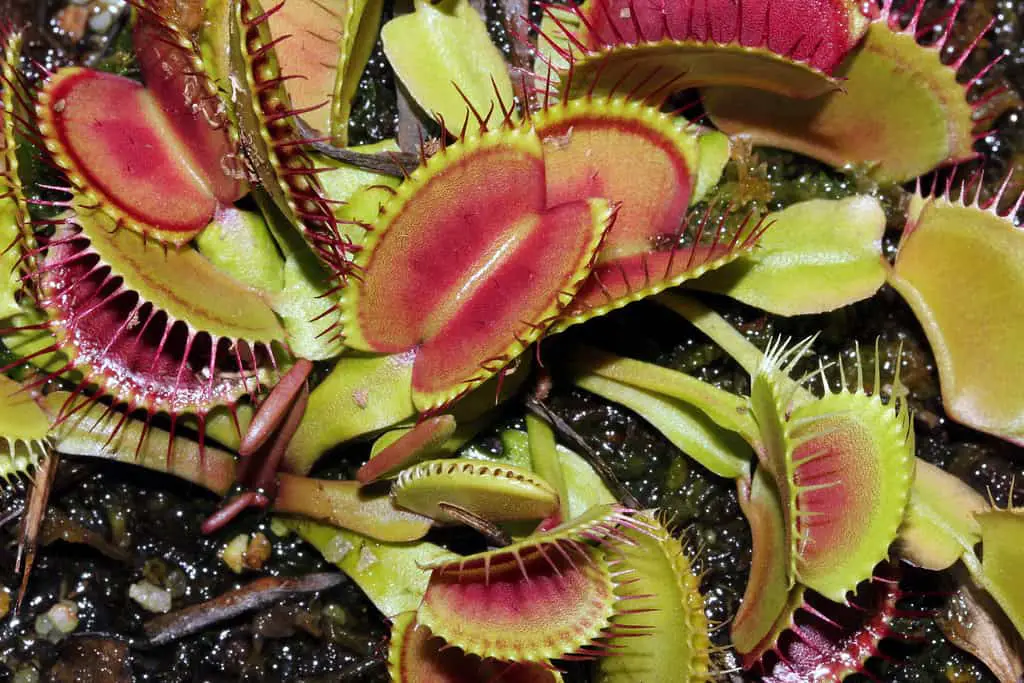
If you are here because you want to buy your first venus fly trap, just bought one and need to know how to care or maybe you already killed one, either way, we have you covered! I hope you have a nice refreshment ready while you learn the ways of the venus fly trap!
Ultimate Venus Fly Trap Care Guide
I just real quick wanted to give you a quick blurp here on how this guide will work. If you are searching for something specific, I do have a table of contents just below. It will guide you to a certain section and help you navigate this fairly long guide. Remember, you can always use control F to search for certain words too!
Simply click any topic in the table of contents below and you will be taken right to that section. Also, you will see a little arrow in the bottom right part of the page, this will shoot you back up to the table of contents!
I truly hope you find this useful, I spent a lot of time preparing this post just for people who are eager to learn about these wonderful carnivorous plants!
How Does A Venus Fly Trap Work?
I figured we would start this venus fly trap care guide with an introduction to this amazing plan. If you just want the care goodies, keep scrolling or use the table of contents above to jump to a new topic!
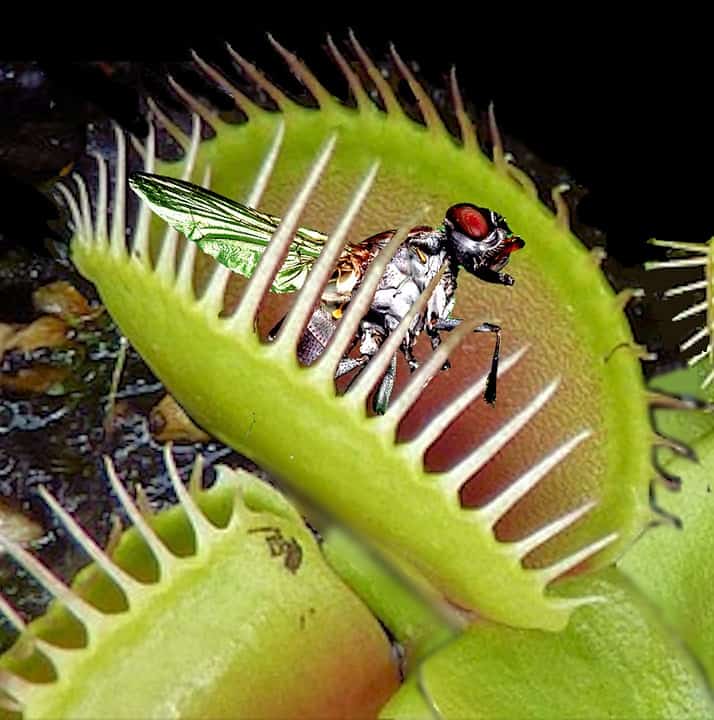
The quick answer to how does a venus fly trap work is as follows. The trap or head will open up wide and invite it’s prey. The flytrap has small trigger hairs that grow on the inside of each trap. When the prey lands inside the trap it triggers the short hairs the venus fly trap will snap shut. The Fly Trap then releases an enzyme that breaks the insect down and takes what it needs!
Let’s dig just a little deeper into this process.
Why Do Venus Fly Traps Eat Insects?
To really understand everything you need to know about a venus flytrap it’s important to know where they come from. They naturally grow in bogs which can be incredibly hard for plant life to survive. The bog environment keeps the soil almost completely lacking in any nutrients and everything is always in a state of decay.
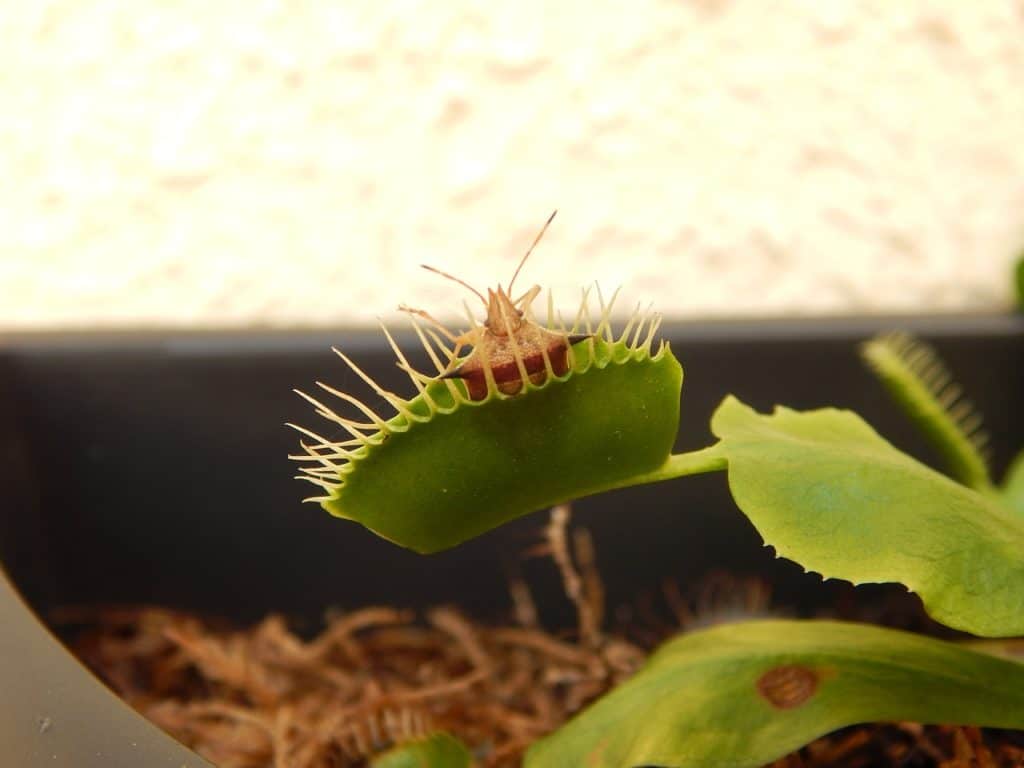
The venus flytrap had to come up with a way to obtain it’s nutrients by some other means than just through its roots. This is how it developed the ability to catch and utilize insects. This process developed due to the basic need to survive. The plant realized it wasn’t going to survive or grow strong in the bogs, it needed to learn how to eat insects!
And evolve they did! Lets talk about what actually happens when a venus fly trap catches its prey.
How A Venus Fly Trap Catches Insects
Out of all the things I’ve learned about a venus flytrap this maybe the most incredible. These plants have really become efficient and super smart when it comes to catching insects.
When a trigger hair gets bent to stimulated the venus fly trap sets an internal 20 second clock. If the hair is not stimulated again within the 20 seconds the fly trap will not close.
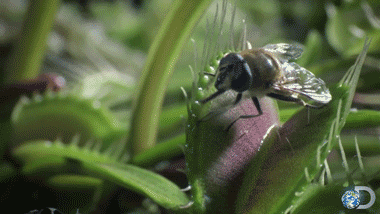
The venus flytrap consumes a ton of energy closing it’s trap. This is a fail safe it’s put in place to avoid being triggered by a rain drop or falling leaf. Once the 20 second clock gets to 0, it resets and the hair must be stimulated twice to get the trap to close. The trap closes in less than a second to trap it’s prey.
If the trap is triggered and it misses it’s prey, it will reopen to try again in 5 to 12 days. That’s quite a bit of time to pass with no opportunity to catch any food. This is why it has evolved with the fail safes.
How Does A Venus Fly Trap Digest Food?
Once the trap closes it more or less turns itself into a stomach. It will release enzymes to help break down the insect. The insect is rich in nitrogen and once it is broken down the venus flytrap absorbs everything it needs.
The flytrap will then open and reveal the “shadow skeleton”. This is the dried up outside of the insect. The skeleton blows away or falls out of the trap to allow room for the next prey!
There is a little more to this entire process but that’s pretty much the jist of it. Please, if you would like to learn more about how a venus fly trap works, click the link below to be taken to a different page on this site!
How A Venus Fly Trap Works – Full Details!
Also, check out the cool video below on how the venus fly trap works on the inside!
Venus Fly Trap Dormancy
For the next part of the venus fly trap care guide were going to talk about dormancy. Most of the time when someone starts caring for a venus fly trap they have no idea that they go into a dormant period. It’s extremely important to understand how venus fly trap dormancy works for the long term health of your plant. I see many people complaining about the loss of a venus flytrap that didn’t even know these plants went dormant.
The misconception is that venus flytraps are tropical plants that need humidity and heat. This is not the case, they thrive in conditions that get cold in the winter time. They are a hardy perennial that go into a dormant stage when the temperatures get cold. Many people mistake a venus fly trap being dead vs dormant. We will get more into that below.
Hardiness Zones
Throughout this entire article I may refer to a different zone. The map below will display where you are in the US and what zone you live in. This will help you determine what type of care your venus fly trap will need during the dormancy period.
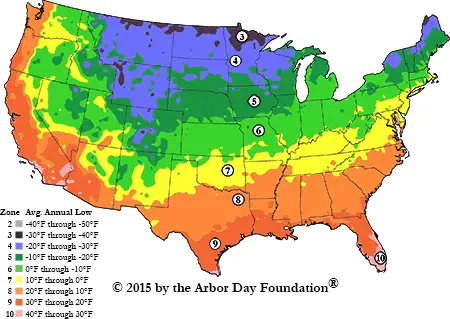
Thank you USDA for the map!
Now that you know which hardiness zone your in we can continue on with venus fly trap care during dormancy.
Dormancy Care For A Venus Fly Trap
First and foremost, the best venus fly trap care tip I can give you for dormancy is to see if there are any growers in your area. I’m going to try my best to give you certain care needs for most areas but it can vary from place to place. Finding someone in your area that understands how to successfully grow venus fly traps can really improve your chance of growing a healthy plant!
Methods for caring for a venus fly trap during dormancy range from creating a bog garden all the way to storing them in a refrigerator. I”m going to try my best to cover all your options!
Water
One of the first rules is that during dormancy the venus fly trap will require less water. The cold in the air will eat up less of the moisture and the plant will stay moist for longer. Be careful to adjust your watering routine as too much water can lead to crown rot or root rot.
You want to keep the soil damp but not soaked. The same rules apply for watering a venus fly trap, which we will get to later. The only difference is that the water will stick around longer now. Never let the plant completely dry out.
Sun/Light
A venus fly trap still photosynthesizes during the winter and will still require ample amounts of sun, if possible. No insects will be caught during the dormancy period so its important to get your venus fly trap as much energy from the sun as possible. If you can replicate their natural growing conditions they will still actually grow during dormancy.
There is an exception to the light rule. If your flytrap will be in conditions that are consistently below 40 degrees it can be in the dark. The plant will actually enter a state of suspended animation and although it won’t grow it will live during this period. It’s not the most idea for the plant so if you can avoid temps this low, it is recommended.
The best rule is to just keep giving your plants as much of that light and sun as possible, even when in a dormancy stage.
Is My Venus Fly Trap Dormant or Dead?
This is a really common question and many people that don’t understand dormancy assume that the drop in temperatures killed their plant. This is often not the case, they have just entered dormancy.
Is My Venus Fly Trap Dead?
The biggest tell for a dying venus flytrap is the speed in which it seems to enter this state. If the plants starts to turn black rapidly it’s likely that your flytrap is dying. If the plant looks really sick and turns a dark color over a couple of days, its likely that your plant is either dead or dying. None of the plant will keep green and it will turn into a mushy pile.
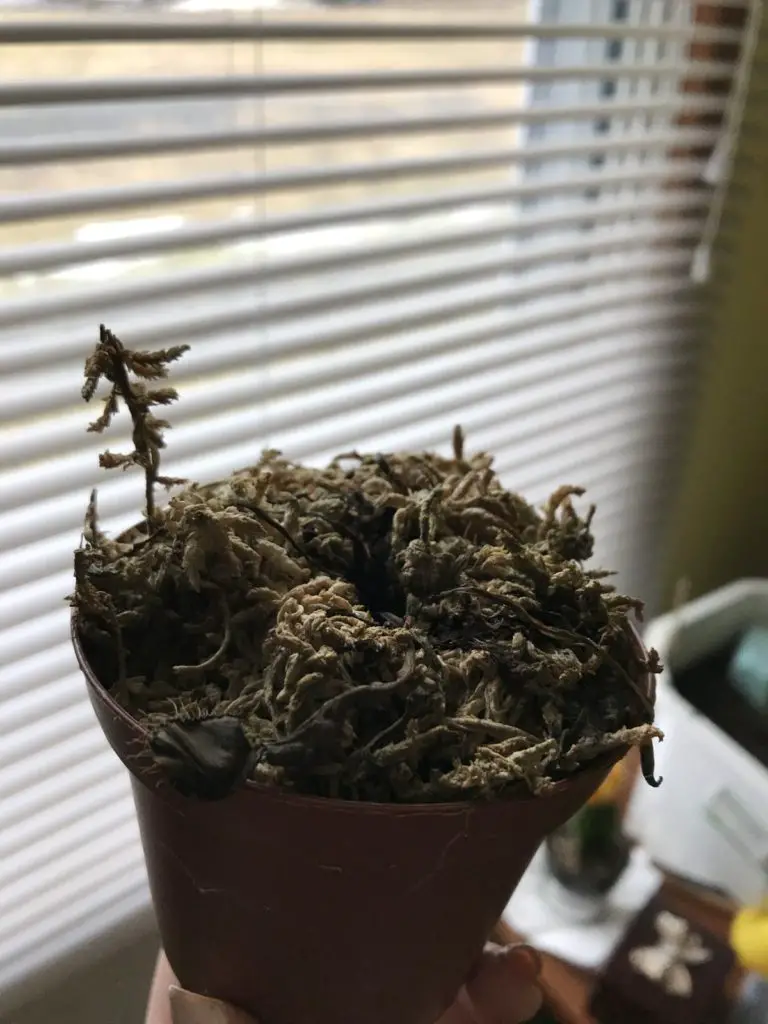
Is My Venus Fly Trap In Dormancy?
Venus fly trap dormancy will happen at a much slower pace than a dying plant. Dormancy can take a span of several weeks to fully kick in. Also, the entire plant doesn’t go black, it will keep some green leaves.
Probably one of the biggest signs of dormancy is considering the time of the year. Is it autumn or fall and the temperature going down a bit? If this is the case and you see the changes starting in your flytrap this is likely dormancy. If you see these changes in spring and summer there is definitely more reason to be alarmed as this is when these plants tend to flourish.
Always look for that little bit of green as a sign of life. The golden rule is, if you are unable to tell if the venus flytrap is dormant or dead, just wait. The best way to tell is to wait it out. If it was dormant it will snap out of it when the temperatures start to warm in spring/summer. If it’s dead, it will likely just stay that way.
Venus fly traps are in a very fragile state when they are dormant. It’s really important that you are not digging the plant up or re-potting during this time. It’s common for people to start digging around or consider re-potting because they think the plant is dying. If its in it’s dormant state it’s probably best to just leave it alone. Keep giving it the proper amount of water and as much sun as possible but do not mess with the roots or plant itself.
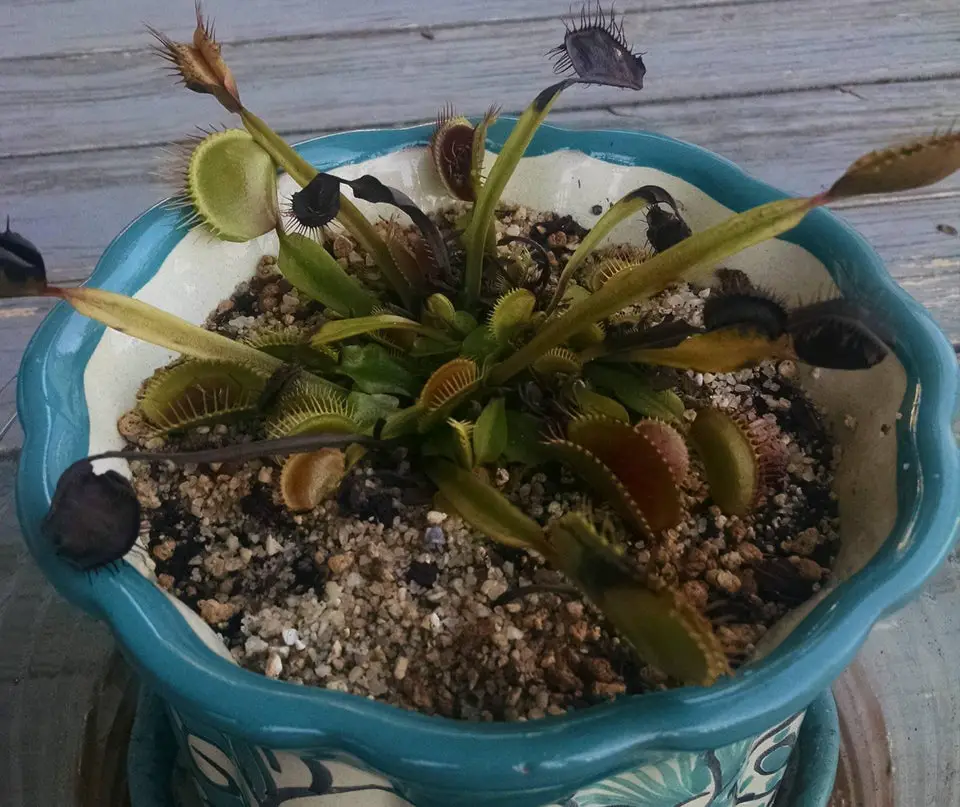
Dormancy Time Is Here: Now What?
Were going to start talking about the hardiness zones we spoke about above. If you live in zones 8-11, congratulations! You have as close to the perfect growing conditions as there is for a venus flytrap. You really don’t have to do anything. Just leaving them alone during winter, keeping them watered is really all you need to worry about.
Outside Dormancy
If you find yourself in zones 4-7 and you want a venus fly trap you will be able to keep them outside, they just need a little more attention. To care for a venus fly trap during cold winter temperatures its recommended that you plant them in a bog garden. Being in a raised pot can make them more susceptible to harsh weather.
If you know temperatures will get close to freezing (in these zones it likely will) you will need to make sure to cover the plants with burlap or a shade cloth. Make very sure you secures the sides with something heave to ensure it doesn’t get blown off. Then cover the cloth or burlap with leaves, straw or pine needles. This will help keep the moisture in and the cold out!
If you get snow, this is totally fine! The snow will actually help insulate the venus fly traps and keep them from getting too cold.
If you want to avoid a bog garden you do have a couple of options. You could get a cold frame, which helps keep your plants insulated and out of the weather. Or you could get a mini greenhouse to keep your plants in. I have links to both on Amazon below!
Inside Dormancy
If you reside in the colder zone 3 or lower you will probably want to bring your venus fly trap inside during the winter months. You will want to make sure that it’s put in a room that stays fairly cold, like a basement or garage. Make sure you keep your plant in a room that stays below the 55 degree mark.
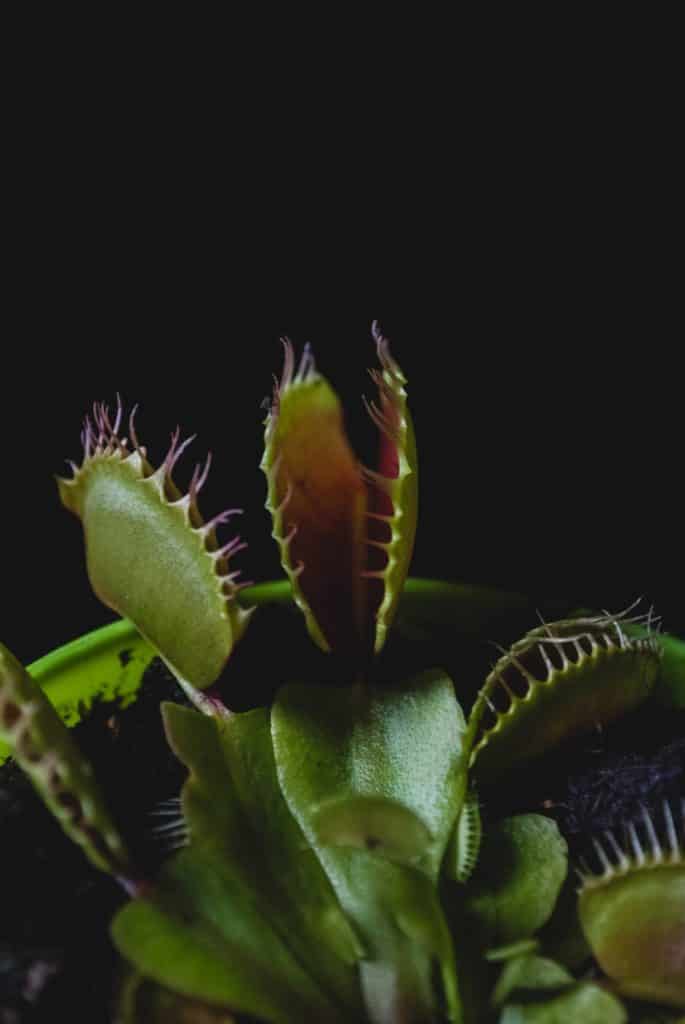
A good rule to follow is that if there are people there it’s too warm. The temperatures that humans are used to being comfortable in are probably too warm. If the plant is heated up and brought out of dormancy too soon it can be trouble for it’s long term health.
Refrigerator Dormancy
No, that’s not a joke and yes, this is an option. If none of the options above work for you, you may want to consider dormancy in a refrigerator. Usually this option is reserved for areas that get way too cold or that stay too warm year round and never go below 55 degrees. Keep in mind, this should be the last option as it’s not as good for the plants long term health but it is an option.
This is kind of a rare option so I don’t want to go into super deep details but I have written an article that goes in depth on dormancy and provides steps for a refrigerator dormancy, click below!
Venus Fly Trap Dormancy and Refrigerator Method
Skipping Dormancy
To keep it simple, I strong suggest not skipping dormancy. It’s important to note that it’s possible to keep a venus fly trap alive for a couple years without going into dormancy. That’s why you see me reference “long term health” often when speaking about dormancy.
If you want your venus fly trap to last for the 20 years it should be able to it needs to go through a dormancy period. This is how these plants have evolved and it’s a very important part of its development and life cycle. I have done a lot of reading and studying on this very topic, anyone who knows what they are talking about promote always going through dormancy.
The short answer for whether you should skip dormancy is, nope!
To give proper venus fly trap care putting your plant through dormancy is going to be very important. It can be a little inconvenient depending on the zone your in, but if you really care for your plant you will do your best to accommodate a healthy dormancy period.
Check out the great video below on venus fly trap dormancy!
Venus Fly Trap Propagation & Growth
We’re going to go over how long it takes for a venus fly trap to grow and how you can propagate a venus fly trap. Let’s quickly talk about how long it takes a venus fly trap to grow then we will get into talking about propagation.

A venus flytrap will grow rather quickly at first. The seeds germinate in as little as twelve to fourteen days. It then slows down. It will take 2-4 years to grow three to six inches tall and about 5 years to get fully matured and grown.
Let’s break down germination and propagation going forward.
Germination
The overall growth of a venus fly trap is pretty slow but the germination period is actually pretty fast and easy! From April until June they will produce seeds. Most soil mixes made for carnivorous plants will work just fine for a venus fly trap. but the best is a sand and peat moss mix. If you want to read more about carnivorous plant soil mix, we will talk more on that later, or you can click the link below. You will be taken to my guide on the best soil mix for venus fly traps!
For a plant to sprout they need to be kept moist. After a few weeks the seedlings will be healthy enough to transplant. You can also wait to transplant until the plant develops its first trap leaves.
Flowering
Many people will grow venus fly traps with the intent to allow them to flower and collect their seeds to grow more plants. The problem is the venus fly trap takes up to 5 years to mature when grown from a seed. From the time you plant a venus fly trap from seed it will take 2-4 years to flower and produce seeds.
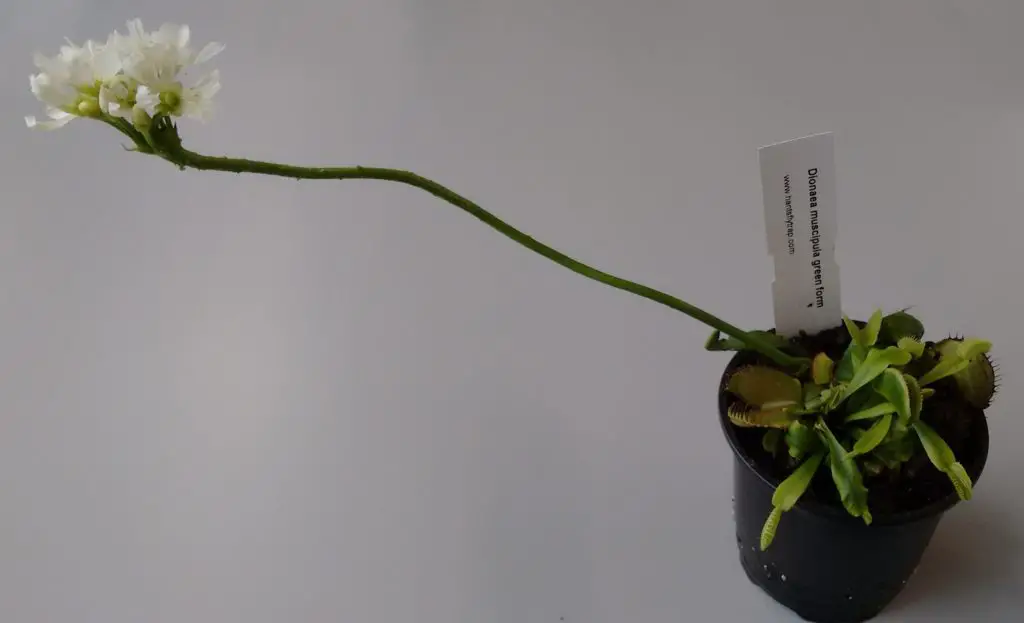
The flowers will appear in clusters of 4-10 and will grow on a large stem that can get as high as 12 inches tall. The flowers are white and shaped like small cups. After the flowers appear the small black pear shaped seeds will be released.
If you are not planning on growing a new venus fly trap from your own harvested seeds it’s actually a good idea to cut the flower off before it gets very big. The plant puts out a lot of energy to help the flower grow to release its seeds. If you cut it off, the plant can focus its energy back on the flytraps and not the flower.
I think that’s a pretty good lead into propagation, since you can actually create a new flytrap plant right from the flower stem.
Vegetative Propagation
Venus fly trap propagation is one of the cooler parts of owning one of these incredible little plants. You can rip parts of them off and grow a brand new one. That sounded a little harsh, please make sure you know where to rip before doing anything crazy!
Flower Stalk Propagation
To grow a new venus flytrap from a flower stalk, you want to cut the stalk off after it reaches about 4 inches tall. Cut it as close to the rhizome as possible, this is the part of the flower stalk that will sprout new growth.
Plant the flower stalk back into the soil and keep it watered well. You will want to be patient as it can take a couple months for new growth to show up. Try to give the plant as much light as possible while your waiting for the new growth.
It’s also a good idea to try and plant the new growth in it’s own pot. I know that’s kind of inconvenient but it will give it the best opportunity to be successful. You can grow it in the same pot as your current plant, it just has a better chance of success in it’s own.
Leaf Pullings
To get good leaf pulling specimens you will need to uproot the plant and expose the rhizome. Try to find the healthiest leaf on the plant and use it as your attempt to propagate a leaf pulling. Once the rhizome is exposed grab the leave and give it a gentle jerk down toward the roots.
You want to try and get as much of the rhizome (the white part) on the leaf pulling as you can. Cut off the trap and plant the leaf in a soil mix that is made for venus fly traps. Give the venus fly trap leaf pulling a lot of light and plenty of water and it should start new growth in about 2 months.
You can read more about propagation and how long it takes a venus fly trap to grow below!
Venus Fly Trap Growth And Propagation
You can also check out the cool video below that shows the growth cycle of a venus fly trap.
How And What To Feed A Venus Fly Trap
In the grand scheme of providing a venus fly trap care, feeding it insects is probably really low on the list. They do need to eat but the sun is the most important thing for them. When it comes to food making sure your venus fly trap gets as much as 5-12 hours of sun a day is probably the most important. We will definitely talk more about that in just a bit.
What To Feed A Venus Fly Trap
Maybe I’m beating a dead horse here but did I mention they need to eat sun? I did? Okay, sorry. I know that’s probably not the answer you’re looking for but don’t worry we are going to talk more about feeding your fly trap insects below.
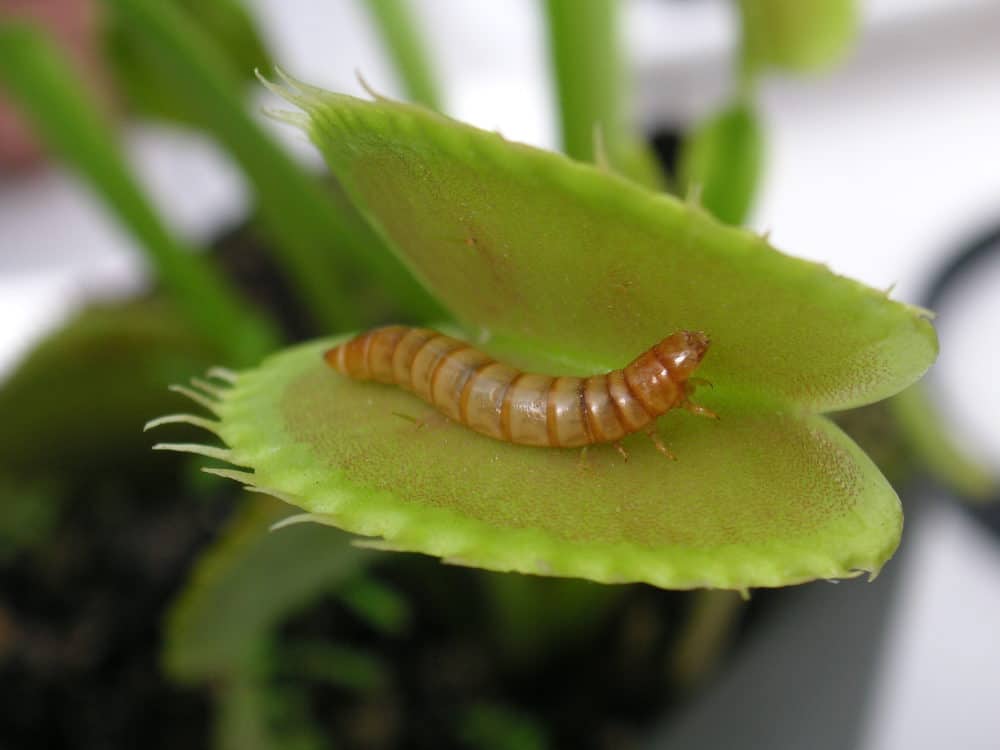
If you are putting your venus fly trap outside on a regular basis it’s probably getting all the insects it needs to survive. The combination of being outside and naturally gather insects along with the sun its getting is probably enough, just make sure to focus on giving it the proper amount of water, more on that later!
I can literally hear you right now, “but I want to feed it bugs!!” Okay, okay lets talk about how often to feed your fly trap and some rules then we will get into what kind of insects you can feed your fly trap.
How Often To Feed A Venus Fly Trap
I know your eager to find out about what to feed the venus flytrap plants but it’s really important that you understand how often first. It’s easy to kill a venus flytrap plant if you feed it the wrong things or too regularly.
The general rule for feeding a venus flytrap manually is you should feed each plant every other week. More specifically, you want to feed just 1 head from the whole plant every other week. You do not want to feed every head on the plant. Just feed one and it will share the wealth.
Let’s go over some rules real quick before talking about what to feed your flytrap.
Feeding A Venus Flytrap Rules
- Many things labeled as “plant food” will be bad for your flytrap. More often than not this is fertilizer and will burn the roots and kill your plant. ALWAYS avoid fertilizer.
- Okay yes, they are carnivorous but no they don’t eat meat. This is a huge misconception with venus flytraps. People ask all the time if they can feed bit beef, raw and cooked. No, this is not good for your plant.
- A venus flytrap loses a ton of energy when the trap closes. Teasing your plant to show off to friends or family is not a good idea. Every once in a while is fine but doing this often will hurt it in the long run. It uses a lot of energy with the expectation to catch an insect that will return what it used up if nothing is caught its just wasted energy.
- Watch the size of the insect you feed your venus fly trap. You want to try and avoid any insects that are more than a third the size of your trap head. Anything bigger can sit for a long time and rot which is bad for the plant.
- The inner workings of a flytrap are very complex. You can’t feed it a dead insect and expect it to complete the process of turning it into energy. Once an insect is caught to ensure the plant doesn’t waste it’s energy the plant will need to be triggered again by a struggling insect. This is the only way the enzymes get triggered and the breakdown and absorption begins. I will talk more about this below under feeding a venus flytrap dead insects.
Feed Venus Fly Trap Live Insects
Alright you ruthless bugger this is what you have been waiting for, ins’t it? You want to feed your venus flytrap a live insect. Okay, maybe I’m a hypocrite this was also what got me interested in these amazing plants. I’ll stop pointing fingers and deliver the goods!
If I feed my venus flytrap insects I do try and make sure it’s a live one. It makes for a great show with friends and it feels good to hear them ooo and awww over your venus flytrap. Just remember the rules above, no over feeding.
A great tip for feeding your venus flytrap live insects is to stash the little critter into the freezer for about a minute before serving. Not too long as it will kill them. This will slow them way down and they will start to wake up as the flytrap closes triggering the process of digestion.
You can get live and dead bugs shipped to your home right on Amazon, how cool! Check out the bugs you can feed your flytrap below and get more info by clicking the links and heading over to Amazon.
Live Mealworms For Venus Fly Trap
Mealworms are nice, they are fairly straight forward. They are also a very nutritious meal for your venus flytrap. Remember if the mealworm is too long you will need to cut it in half. This is important for the younger venus flytrap plants.
You can go down to a local pet store and grab some mealworms but you can also order live mealoworms right off Amazon. Just order and they show up in a few days, super simple! Check out the link below.
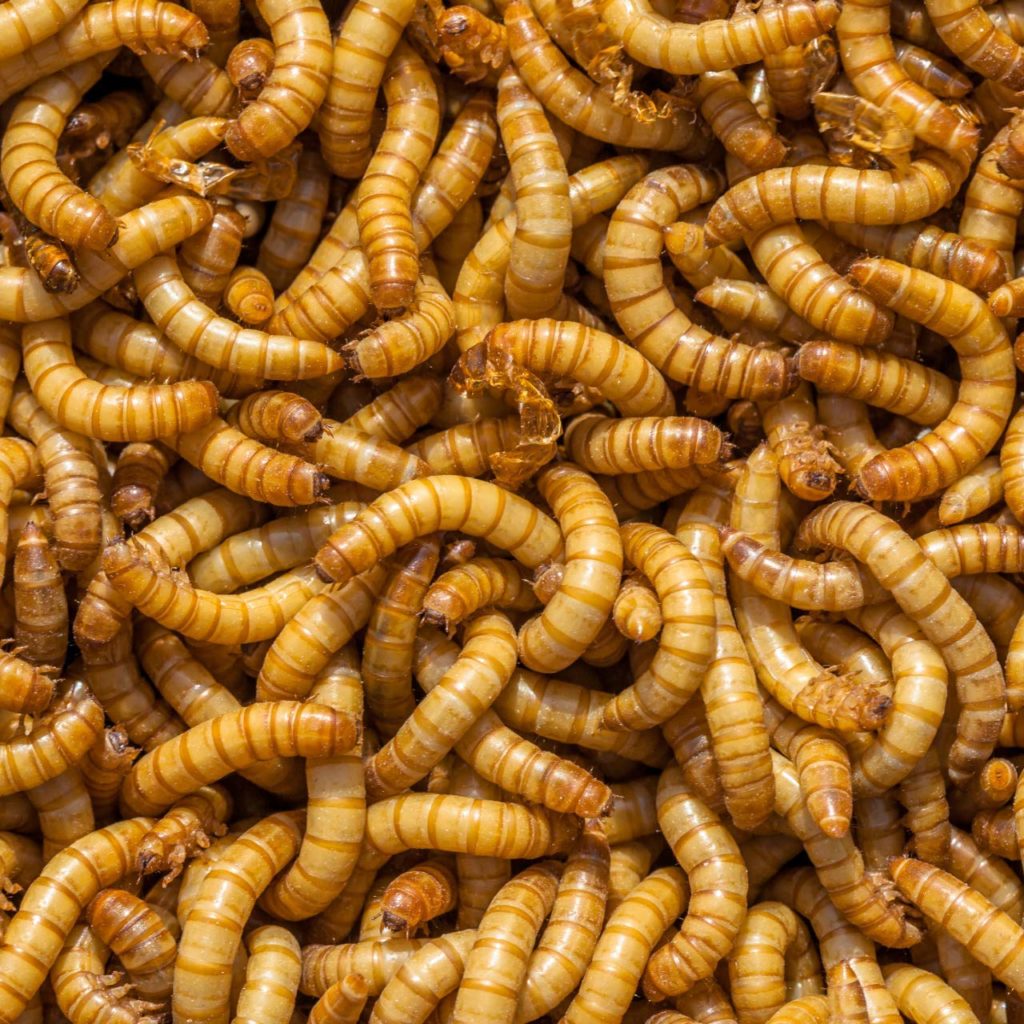
Live Crickets For Venus Fly Trap
Crickets are another inexpensive but nutritious insect you can give to your venus flytrap alive. They are also super easy to buy right off Amazon, I’ll link below!
You can get them in two sizes, 1 inch and half inch, the half inch will likely be better for your venus flytrap. Check them out below!
Buy Live 1/2 Inch Crickets on Amazon

Feed Venus Fly Trap Dried Insects
This is definitely an option but will require you to do a little more than with live insects. It’s certainly possible that even though it’s a little more work that this is an even better option for beginner growers.
I have seen mealworms burrow out of a trap head and crickets are super quick. (Remember the freezer method!) It can be a frustrating ordeal to get your flytrap to eat a live insect.
Just keep in mind if you go this route you will need to use something to trigger the hairs to make sure the flytrap will begin to breakdown and eat the dried insect. Just like the live insects you can get your dried insects right off Amazon!
How To Feed A Venus Fly Trap
Now that you know what to feed a venus flytrap in this venus fly trap care guide were going to talk about how to feed a venus flytrap. Most people think you pop the insect into the head of the trap and the eating ensues. This is not true.
Feeding A Venus Fly Trap Live Insects
There are a few issues you will face when trying to feed your venus fly trap live insects. It’s a little risky since the plant will expel a lot of energy if the insect escapes after the trap closes.
One of the best ways to avoid the insect escaping is to put the insect n the freezer for a minute or two. This will basically stop the insects movement and leave them frozen. Usually by the time the insect can move again the fly trap has it in it’s grasp and the now moving insect will trigger the hairs to start the final part of the process.
Another thing you can do to reduce the risk of escape is to use tweezers. Just grab the insect by the tweezers and put it in the trap, once the trap is closed slide the tweezers out. Make sure you grab a part of the insect that won’t break off like a leg of a cricket.
Although, it’s not my style, you can also remove the legs from the insect that you put into the fly trap. This will make it so they can’t escape. I’m not here to judge, your plant your choice.
Feeding A Venus Flytrap Dried Insects
This is a tempting option considering the insect can’t escape but it’s important you understand how the venus flytrap works before trying this.
If you consider how they have evolved and catch their food you must consider that they are expecting the insect to be wiggling and moving. Another built in fail safe for the flytrap is if the trap closes around a prey and it never moves again, it actually won’t begin the process to digest and breakdown the insect.
This is another thing the venus flytrap has put in place to avoid wasting energy. If it closes around a leaf or something else, it knows not to release the enzymes to breakdown the false catch. No need to waste all that energy for something that’s not moving or wiggling.
If you would like to learn more about this specific process, check out another article I wrote all about how venus flytraps work! You can check it out below.
The trick to getting them to start the digestive process and releasing the enzyme is to stimulate the trigger hairs once the trap has completely closed. There are a couple ways you can do this.
You can gently (very gently) squeeze together a trap head with the insect inside to stimulate the trigger hairs. This is a good way to do it because it also helps the flytrap close down tighter around the insect.
The other thing you can do is to take a toothpick or paperclip and stick it inside the trap head to stimulate the hairs that way. You will know that the hairs were stimulated when the flytrap closes even tighter, initiating the release of the enzymes.
If your venus fly trap opens up a few hours later you will know this was not successful. To breakdown the insect and absorb all its goodness the flytrap will typically take 5-12 days. It will stay closed this entire time.
I do go into more depth on feeding a venus flytrap if you click below. It’s a little longer but has some great info!
You will definitely want to watch the video below showing a venus fly trap feeding on live insects!
How To Water A Venus Fly Trap
One of the most important things in this venus fly trap care guide is going to be learning how to water a venus flytrap. It’s very important that you are giving them not only the proper amounts of water but also the right kind of water.
How Often To Water A Venus Fly Trap
First we are going to talk about how often to water a venus fly trap but please don’t leave here until you also understand what type of water to give your plant. Normal tap water will kill it.
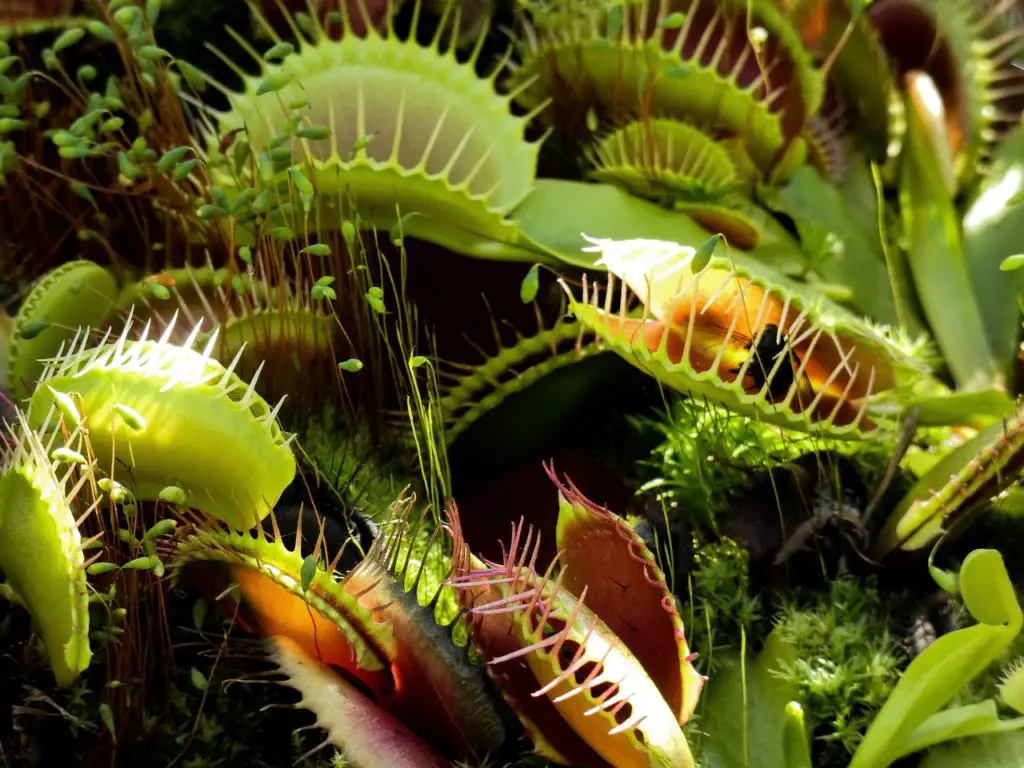
You want to make sure and water your venus flytrap until its moist but not soggy. One way people like to do this is by using a tray with a draining pot or planter. If you keep about 1 inch of water in the tray this will typically keep your plant perfectly hydrated.
This will help make sure the soil can breath and will keep the roots of the plant healthy. Keep in mind that the pot you pick is super important for a healthy venus flytrap. I have written an entire guide to picking out a pot or planter, check it out below!
Picking A Pot Or Plant For Venus Flytrap
It’s also extremly important that you have the correct soil for your venus fly trap. The soil will determine if the water gets clogged up or can drain easily. If the water doesn’t drain you can develop root or crown rot on your plant. Don’t worry, I’m going to talk all about venus fly trap soil mix below. If your not patient however and want to learn more, I have a guide on the best soil mix for a venus flytrap, check it out!
Sorry about that, we got just a little off track. The soil along with pot or planter are very important to ensure that your plant is being watered correctly. Let’s talk more specifically about how to water a fly trap before we get into which kind of water to give it.
How To Properly Water A Venus Fly Trap
You will want to keep a very close eye on your plant during the active growing season. It’s going to get a lot warmer and your soil mix will dry out much sooner. You never want your venus flytrap to dry out completely, so remember to keep a closer eye.
Make sure the soil is moist but not overly soggy or waterlogged. It’s actually easy to over water a venus flytrap so you will want to be careful. They are susceptible to root and crow rot.
What Type Of Water For A Venus Fly Trap
The kind of water you give to your venus flytrap is probably more important than how often you water it. If you give your flytrap tap water it will likely kill it. Unless your tap water is extremely pure and free of minerals.
I’m going to discuss briefly each type of water you can give your flytrap. If you want to read more about each water type, click below to my full guide on watering your venus flytrap. You have all the super important information here but there are some more tidbits on the main article.
Negative Effects Of Tap Water
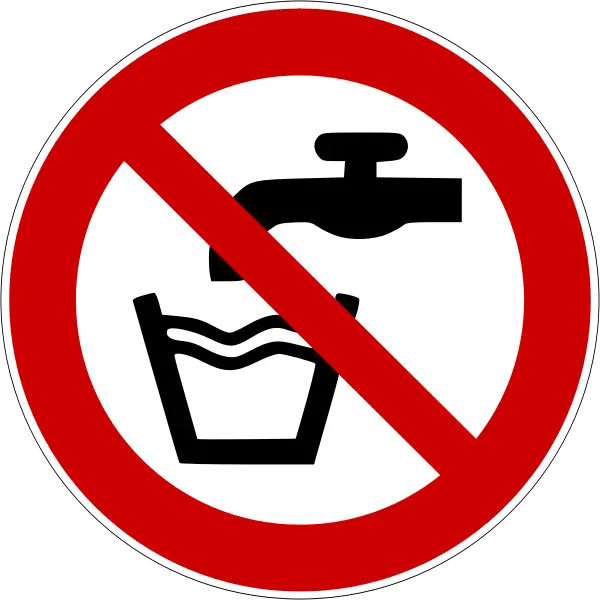
Tap water is not good for most house plants but especially for carnivorous plants such as venus flytraps. It can contain sulfur, chlorine, calcium, sodium, magnesium and other harmful elements. The worst part is tap water won’t kill your plant right away, it will likely lead to a very slow death.
Keep in mind, if you get water from a well or your tap water is very pure, you can actually use your tap water. If you suspect you have super clean tap water there is a way you can test it. If your tap water measures below 50 PPM (parts per million) you should be able to water your plant fine.
I do not suggest gambling with this, a TDS meter to measure your tap water is super cheap and easy to use. You can actually buy one right off Amazon, click below to check it out! Honestly, measuring your tap water isn’t a bad thing even for your day to day life. It’s totally worth it.
Test Your Tap Water With This TDS Meter
Now lets talk about which kinds of water you want to use for your venus flytrap.
Distilled Water
The easiest water to get and to give your venus fly trap is distilled water. It’s free of all the minerals and it’s easy to run to the store and buy. And, if your like me, you can buy it right off Amazon and just wait for it to be shipped to your home! Check it out below.
Click Here To Buy Distilled Water On Amazon
Rainwater
We do our best to collect rainwater and use it as much as possible. We live in the Northwest so there is no shortage of rainwater for us to collect. I plan on making a post all about our rainwater collection process but its pretty straightforward.
We basically just spliced our gutter and put a spout on it that drains into a barrel with a keg style attachment. It makes it really easy! You can check out what we use below to collect rainwater.
Rainwater Collection System On Amazon
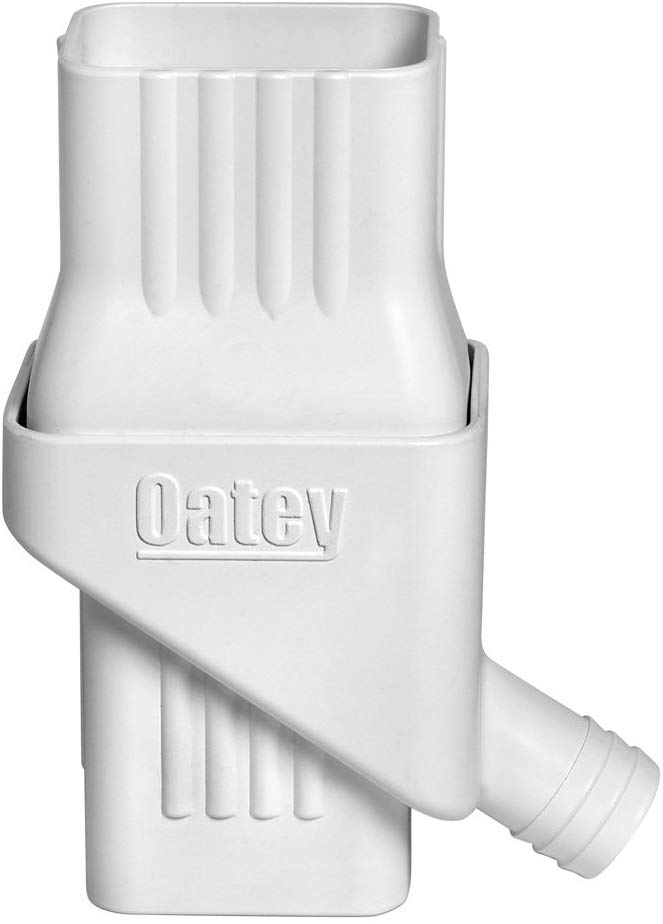
Rainwater Collection Barrel On Amazon
Reverse Osmosis Water System
This is definitely my goal. One day I would like to convert our tap water system with reverse osmosis. This isn’t just good for your plants it makes your tap water super clean and great for everyone to drink. This helps the environment and makes water more accessible. Its a major win win.
The systems are installed under your sink and are definitely the least convenient options for your venus flytrap. They can be a little pricey but for what your getting the price is justified. You can check the one out below on Amazon, when I pull the trigger it’s definitely the system I’m getting.
Reverse Osmosis Drinking Water Filter System
You can also watch the super in depth watering video below, it is really helpful!
Venus Fly Trap Soil Mix
Next for this venus fly trap care guide we are going to talk about what kind of soil you need for your venus fly trap. Again, unlike most house plants vensu flytraps do things just a little different. They grow in bogs where the soil is extremely poor in nutrients. We need to try our best to mimic that environment and give them a nutrient poor soil mix.
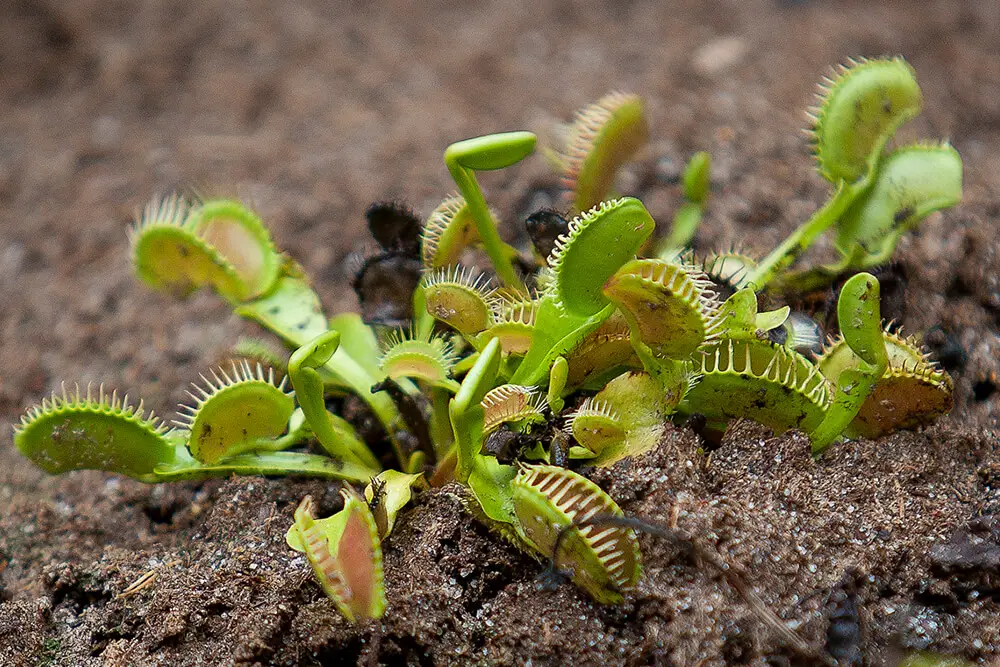
Like all my other sections, I do have an entire article completely devoted to just soil mix for a venus flytrap. I will cover everything you need to know below but you can definitely check that out as well!
Let’s not beat around the bush or traps? I don’t know, sorry, bad joke.
Best Venus Fly Trap Soil Mix
The best soil mix for a venus flytrap is 5 parts peat moss, 3 parts silica sand and 2 parts perlite. To have a healthy root system with good aeration the silica sand can really help.
The most important thing for this soil mix is to ensure that it’s nutrient poor. Any kind of soil from your yard or anywhere else will kill your plant. Anything that says it’s enhanced or has fertilizer will be bad.
Some experts out there will use a diluted fertilizer on the leaves but it’s super risky and not recommended for new or beginner growers. This may be a solution to help your plants grow in certain situations but not one you should explore unless it’s absolutely needed.
You will want to stick with the 3 main ingredients, keep it simple.
Peat Moss
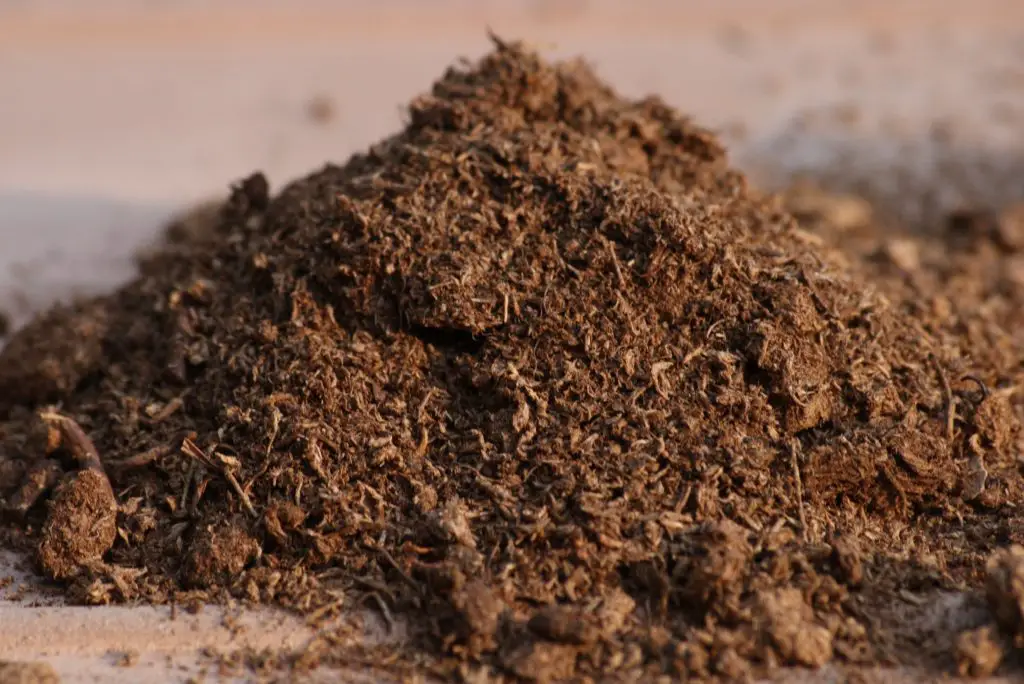
It’s nutrient poor and is great for aeration. It’s also pretty inexpensive and can be picked up at any nursery or big box store. Try to get the variety with long fibered sphagnum as it’s even better for drainage. It also helps the perlite not float to the top.
Do beware as some companies that sell peat moss will enhance it with fertilizer, this is not good. You want to stay away from this type of peat moss.
Perlite
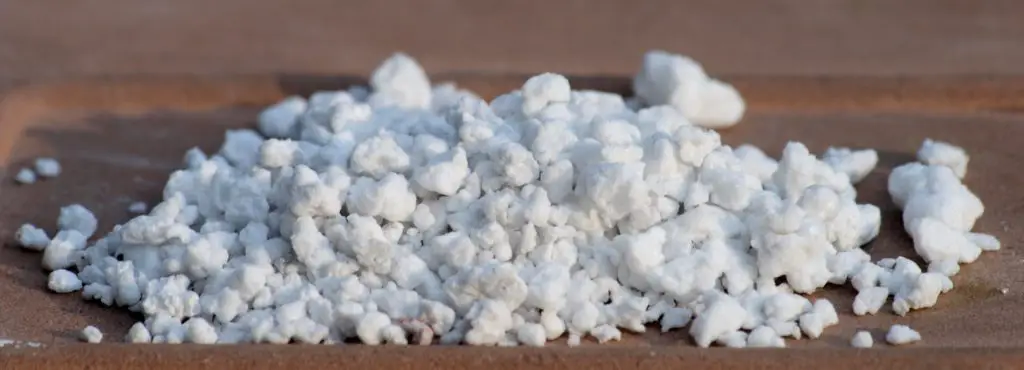
Perlite are those tiny white specs you often see in potting soil mixes. It’s great because it aids in water retention and helps keep the soil aerated. It helps keep the soil loose and less compact assisting with water drainage. It’s super easy to find and can be found almost anywhere selling plants or plant supplies.
Silica Sand
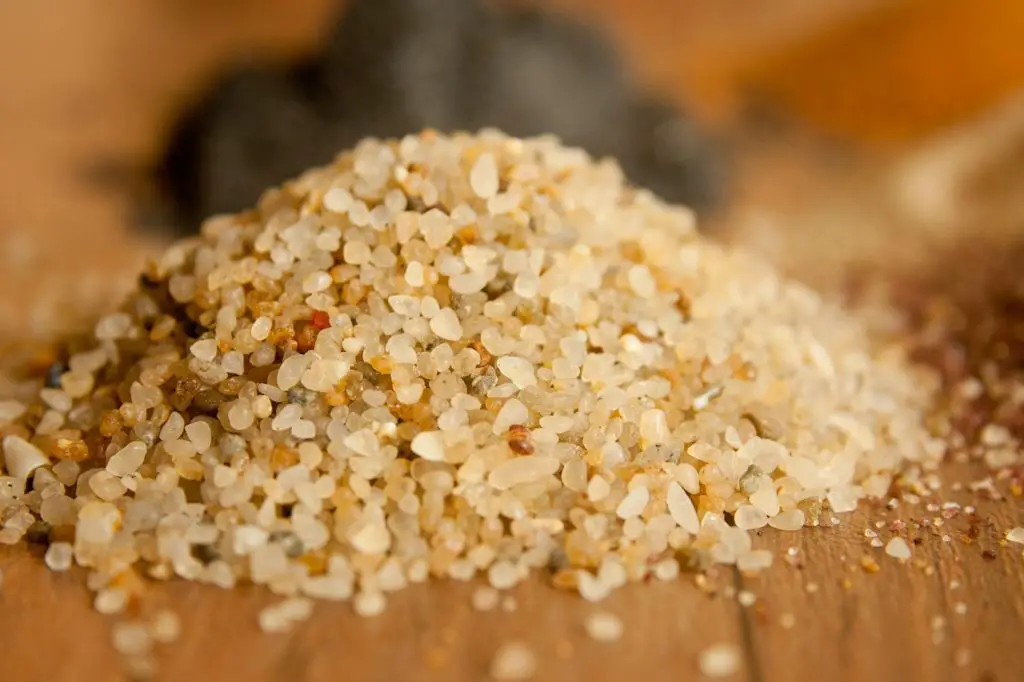
This is kind of the secret ingredient as it’s not necessary but will be great for your venus flytrap. It works with flytraps because it’s not soluble and is completely neutral. This means it wont leach any extra nutrients into the soil that can harm your plant.
It can really help your plant form a healthy root system as well as promote great aeration.
Now that you have all your ingredients. You will want to clean the Silica and Perlite in some distilled water to ensure it’s cleaned off of any extra minerals. Just put the water in a large container and dump in the sand and silica. Shake the container, and dump out the water. Rinse and repeat (literally).
Once you have cleaned your silica and perlite you can just mix all the parts together. Mix in some distilled water to get your soil mix moist and ready to plant. It’s going to take more distilled water than you think since everything will absorb the water.
Premixed Venus Fly Trap Soil Mix
Going to the store and getting all the ingredients and mixing it together is a lot of fun for a plant nerd like myself. But trust me, I understand that everyone is not like me. You have a life and just want to buy some soil mix that will be great for your venus fly trap. I completely understand! There is a great mix you can buy on Amazon that will come ready for planting. Check it out below!
Click Here For A Soil Mix On Amazon
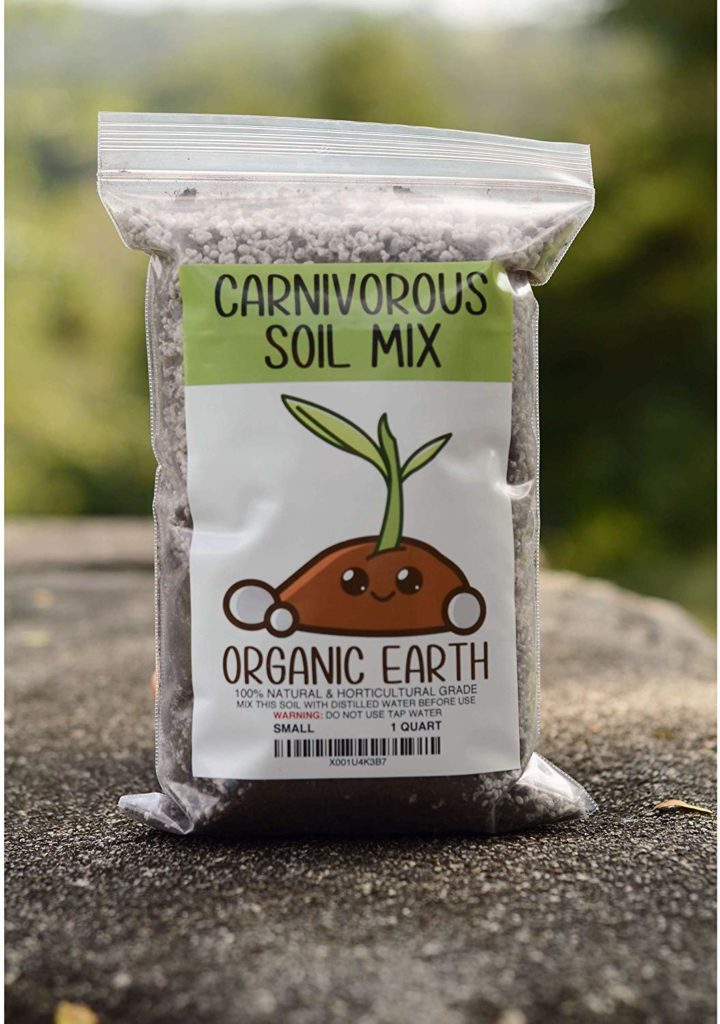
Choose A Pot For A Venus Fly Trap
Choosing the right pot for your venus flytrap is super important. Having the right pot can make your job super easy or very difficult. In the ultimate venus flytrap care guide we are going to take some time to talk about the best planter or pots for venus flytraps.
Things To Consider When Choosing A Pot
There are some simple rules to follow when looking for a new venus fly trap pot or planter. When seeking the perfect pot or planter the first thing we often consider is looks. We want the planter that will match our home or other pots and planters. Luckily, being able to shop on Amazon for these kinds of things the options are almost limitless. There are a few things you need to consider.
Drainage
Picking a pot with drainage holes in the bottom are an absolute must. If you find the perfect pot and it’s made out of the right material (more on that below) and it doesn’t have drainage holes, you can always drill your own! Keep in mind this can be a little dangerous with ceramic as you always run the risk of breaking the pot.
Colors
People don’t often consider the color of their planter important. One of the most important things for a venus fly trap is ample amounts of sunlight. If you get a black or super dark planter often times this can bring in extra heat that can be harmful to your plant. Try to aim for something that is lighter in color, especially if your plan is in the sun often. The heat can bake the roots and kill them from the inside.
Pot Material To Avoid
The most important thing here is that you avoid terra cotta that is unglazed. They are super porous and can dry the soil out faster than the other materials. Terra cotta pots can also leach salts into the soil and over time can put a strain on your plant. It’s not likely to kill them but it can make them less healthy or grow smaller.
Generally speaking, I would avoid any pot or planter that are super breathable and porous. It dries out the soil too quickly and those types of planters can leach minerals into the soil.
Pot Materials To Look For
Lets talk for a little bit about the best pots and planters you can find. I’ll go over the types of pots and give you some examples. Feel free to go out and find the ones you really like on Amazon however. They have so many options from all the types I give you below. I’m sure the perfect pot or planter is out there waiting for you!
Plastic Planters
Plastic planters are the most afforable and easiest to manage. They work great! They are also super easy to drill more holes into if you decide you don’t like the drainage. If they break it’s not a big deal since they are really inexpensive.
They do have some really cool inexpensive and colorful plastic planters out there that work great for carnivorous plants and venus fly traps. I’ll put a link to some of my favorites on Amazon below. They are colorful and have lighter colors and have drainage holes. They are sold ready to go!
Cool Plastic Planters On Amazon
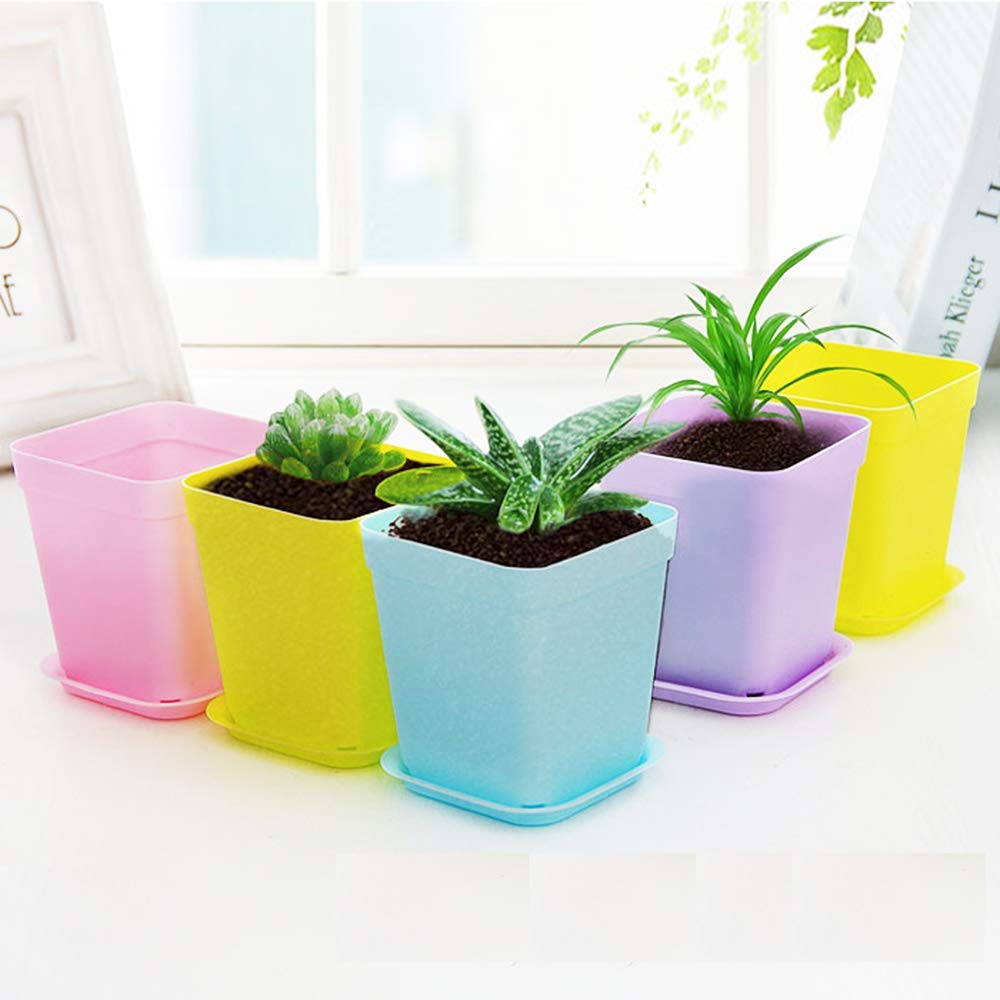
Resin Planters
I saw that look on your face when I suggested plastic. You scoffed and quickly decided that plastic was not the route for you. I get it, I’m more of a resin person myself. Plastic makes the most sense, but who wants plain old plastic when you can get resin pots and planters that are beautiful and creative.
Well, the jokes on you. Resin basically is plastic just a thicker cooler version of it. There are some really cool resin planters out there and the options are basically limitless. If you can think of a color or design, it probably exists on Amazon. I’ll show you some of my favorites below then you can go check them out yourself!
Oh whiskey barrels, I’m so basic. I always love a good whiskey barrel and venus fly traps look great in them. Check out the cool whiskey barrel resin planter below. They have a couple of different sizes and options.
Whiskey Barrel Resin Planter on Amazon
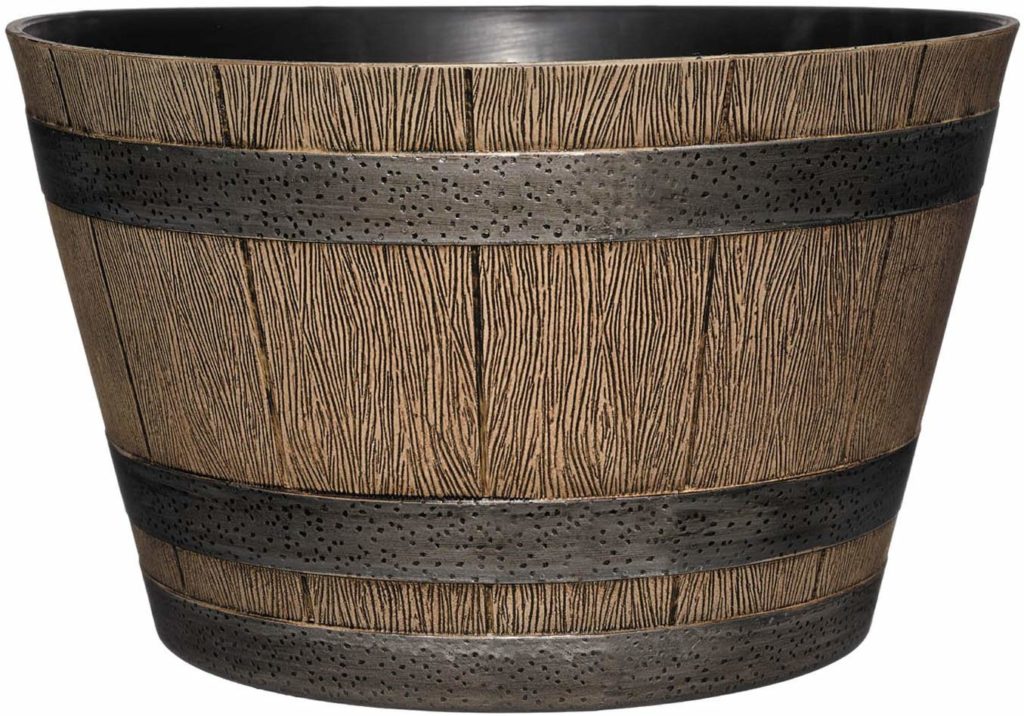
Maybe you are looking for something a little bigger and a little more fancy. Maybe you want to plant multiple carnivorous plants or multiple venus fly traps. You can actually take something like the planter below and create an entire bog garden. Which can be really neat with different types of venus fly traps or other carnivorous plants.
Just remember, the most important thing with resin planters is to make sure they have good drainage holes. If they don’t and you have to have the planter keep in mind that you will want to drill a couple of your own holes. The nice thing is that resin makes that super easy without the risk of ruining your entire pot. You can check out a multitude of other resin planters for your venus fly trap below.
Glazed Ceramic Planters
If you really don’t want a plastic pot or planter for your venus fly trap then glazed will likely be the best option. The same rules apply, just find one that has drainage holes. Drilling your own holes in a ceramic pot is doable but a lot riskier. You also want to make sure the ceramic is glazed on the inside and out. If its only glazed on the inside the ceramic can leach minerals into the soil and be harmful to your plant.
The nice thing about glazed ceramic planters is you can obtain a look thats a little different than plastic. Check out the pot below as an example of what you can get!
Click Here For More Photos On Amazon
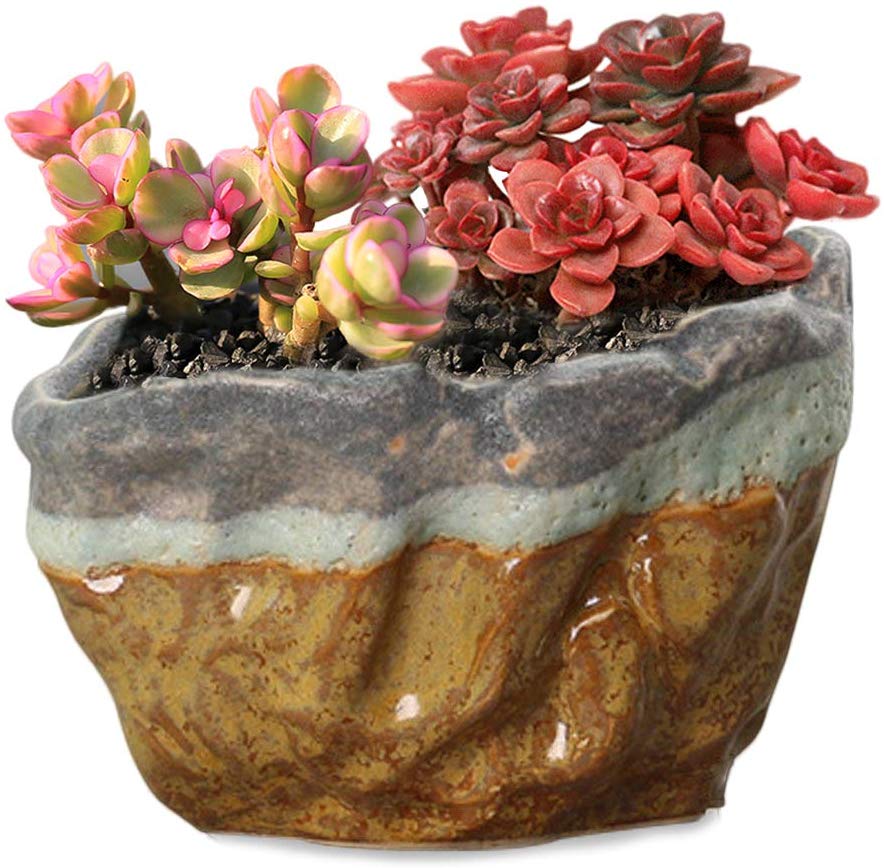
There are so many great options when looking at all the really cool ceramic pots and planters on Amazon. If you can find the one you like that’s glazed and has drainage holes then you should be good to go! You can check out more really cool glazed planters below on Amazon.
Glazed Ceramic Planters on Amazon
How To Repot A Venus Fly Trap
With the next section of the venus fly trap care guide were going to talk about repotting! Now that you understand how to pick out the perfect pot and you know how to make the perfect soil mix for your venus fly trap, it’s time to learn out to pot and repot. It’s actually pretty simple and not all that different than other plants but I’ll definitely break it down for you below.
Before we jump in, lets talk about the Rhizome. I’ll be referencing it below so you should know what it is. Its the bulb-like white part that is just below the soil and just above the black roots. When it comes to plants and propagation the rhizome is something that will come up often. Leaves from the plant typically can be traced down to the rhizome and it’s where the plant stores most of its energy.
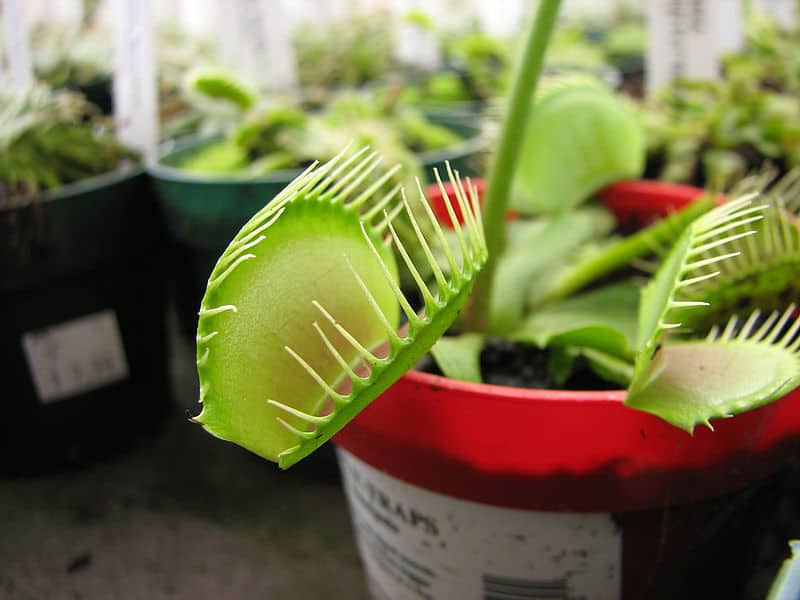
Steps To Repotting A Venus Fly Trap
I’ll break this down for you into some easy steps. It’s not an overly difficult process but it’s nice to know the steps to make it a little easier on your plant.
Get The New Pot Ready
You have your soil ready to go and it’s time to introduce your plant to it. Grab some soil and put it in the pot or planter. Fill it to the top then compress it a bit. Use your fingers or a tool to dig a fairly deep hole. Make sure the hole is deep enough to stretch the roots all the way out. Try not to loop the roots, give them a lot of room to stretch and grow.
Preparing And Uprooting
Give the planter it came in a gentle squeeze to help dislodge it. Turn the old pot over and remove the plant. Make sure you are holding it in a way you won’t drop it.
Break the soil away from the roots. During this process go very slow and be very patient. This is the time your plant is most likely to be hurt during the repotting process. You can also dip the roots into some distilled water to help remove the old soil.
Plant In New Pot
You already dug your hole and the plant is cleaned off, it’s time to put it in the new hole. The most important thing here is to make sure you use your finger to help the roots get as deep into the hole as possible. You can also use a stick or screwdriver to help with this. You might need to adjust the depth of your hole, which is perfectly fine. Make sure the Rhizome is just below the soil when you cover with the new mix.
Compact the soil around the rhizome very gently but snugly. You may need to grab a little extra soil mix to make sure that the rhizome is completely covered. It shouldn’t be very deep but none of the white form the rhizome should be exposed.
Water The Fly Trap
It has been a long and tiring journey for your venus fly trap. It’s time to give it a nice drink of water. Watering immediately helps eliminate any air pockets that have developed and can help reduce root shock that may have happened with repotting.
Try to make sure when you water the top of the plant that you do it very gently. If the water hits the soil too hard it can separate the peat moss and perlite and the perlize can rise to the top. You can even put the water on the plant it’self and let it drip down into the soil. Watering the plant directly does not hurt it. If you haven’t read the guide to watering yet, make sure you do! You will want to make sure you are using the right type of water.
Check out the great video below showing someone repotting a venus fly trap!
Venus Fly Trap Terrarium Care
I wanted to take a quick moment to cover caring for a venus fly trap in a terrarium. I strongly recommend that you don’t do this. Venus Fly Traps are not the type of plant that thrives in that kind of an environment. They are a hardy perennial that like to have all seasons and need a dormancy period. Terrariums are designed to simulate a humid jungle like environment. Venus fly traps are not tropical plants. This wouldn’t feel like a proper venus fly trap care guide without informing you of this.
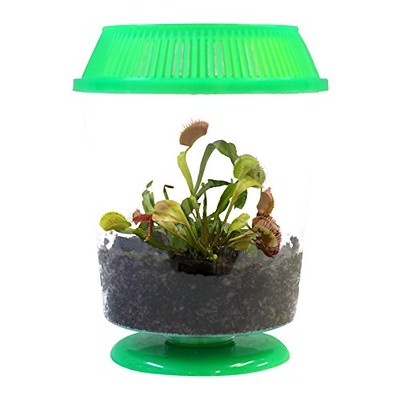
If you have the option not to use a terrarium I would go that route. The vast majority of people who try to grow venus flytraps in a terrarium end up killing it. I talk about this in long length at the link below. Please go check it out for more information. Especially if you are considering using a terrarium.
Venus Fly Trap In A Terrarium, Good or Bad Idea?
Conclusion
Wow, that was a little long winded. I really hope this ultimate venus fly trap care guide has helped you out. Caring for a venus fly trap is important to me and all I want is for you to have a good experience and help your little (or big) plants thrive. They are really special plants and although they require a little special care, it’s 100% worth it.
I hope you go out and get your plant right now or at least have a better understanding of your plant you already own. Take great care of your venus fly trap and here’s to years of healthy growth and successful propagation!
Ultimate Venus Fly Trap Care Guide: Caring For A Venus Fly Trap
A quick shout out to some of the sites I have frequented over the years for knowledge and help.
https://carnivorousplantnursery.com/


